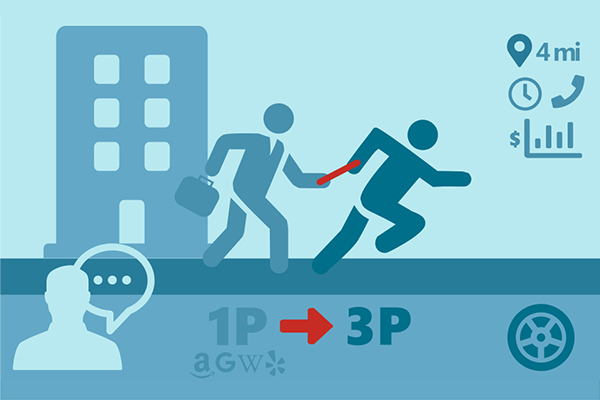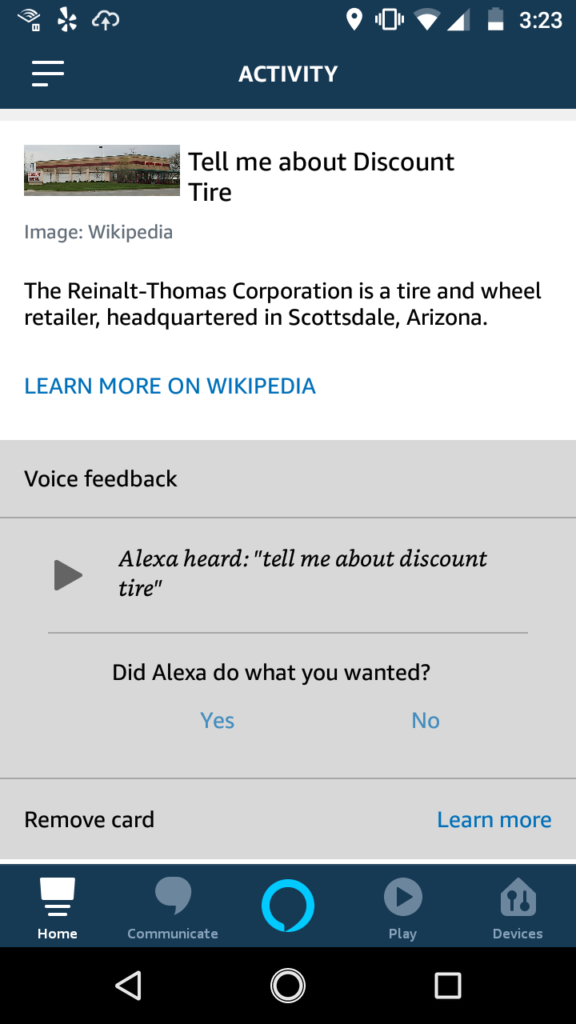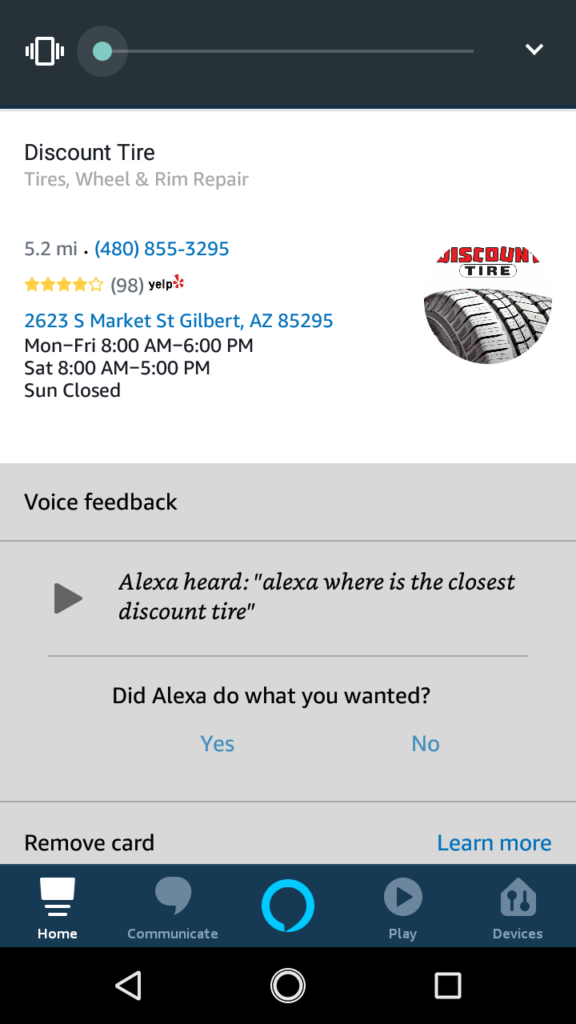Better Business Conversations Start with Third-Party Voice Apps, But First-Party Rules Today

Image Credit: Mark Tucker
There is a commonly expressed feeling in the voice community that just as every business needs a website, they also need a voice presence. Many voice agencies are staking their existence on that assertion. Today, voice assistants can give you a short summary of a business or the closest location. For voice agencies to succeed, the conversation about businesses needs to jump from a first-party to a third-party experience.
First-Party is the Default Today
Let me illustrate this with an Arizona-based company, Discount Tire. If you ask Alexa or Google Assistant “tell me about Discount Tire” you will get the same result: the first sentence of the Wikipedia article.
Notice in the screenshot from the Alexa App, that the parenthetical phrase is omitted, leaving the customer confused about why the answer is about the Reinalt-Thomas Corporation. Google Assistant makes this same omission.

Image Credit: Mark Tucker
This conversation between user and voice assistant is handled as a first-party experience meaning that the answer is provided directly from Amazon or Google. They are both using Wikipedia as a service in this instance. In order to improve the customer voice experience, the company could craft a more voice-friendly first sentence and update Wikipedia. Many companies would be discontented with that minimal level of control over their customer communications. And, they should be. What if they wanted the response to:
- Be two sentences instead of one?
- Correctly pronounce a word that is commonly mispronounced?
- Include a celebrity voice?
- Include sonic branding?
The next phase of business integration needs to include control over those choices. Continuing the example above, when asked, “Where is the closest Discount Tire?” both Alexa and Google Assistant correctly picked the closest location. Alexa uses the services of Yelp to answer and Google uses it own services. Here is the response in the Alexa App:

Image Credit: Mark Tucker
For Alexa, companies have little control over the Yelp response including the poorly cropped logo in the app. In the case of Google Assistant, they are likely using information provided to Google My Business. Interestingly, Google My Business currently doesn’t ask for any voice-first content. Once again, this customer experience is completely first-party.
Moving from a First to Third Party User Experience Offers More Brand Control
In these examples, there is little for a voice agency to do other than provide guidance on where to make content changes. What agencies need to be able to sell to companies is engagement, interactivity, and usage statistics; a demonstrated result. Agencies need to be able to show a company that before engaging their services, a customer got a single sentence in response to “tell me about your company” and after the company controls the experience. Even though the experience might start as a first-party experience, they want customers to seamlessly move into a third-party experience where they have more control.
Google Actions already provide a brand verification step where a Google Action can be associated with a company website and it wouldn’t be difficult for the Alexa Developer console to provide this business profile information. Then businesses could choose whether they wanted responses to come from Wikipedia, Yelp, Google or the company’s voice application. Agencies could also design, develop, and deploy third-party voice applications. This is where voice agencies can then provide their expertise for a fee and both the company and agency benefit. Google and Amazon would benefit also as better customer experiences about businesses will encourage customers to use voice assistants more.
Public Alexa Skill Blueprints for Businesses Could Help, But Have Limitations
With the recent release of Alexa Skill Blueprints that can be published to the Alexa Skill store, it might seem logical to provide an “Alexa My Business” template that would provide the same functionality of Google My Business but from a voice-first perspective. The skills created from this template would still be considered third-party could then be transitioned into a first-party experience.
There are limitations to blueprinted skills. I’ll mention two. First, unlike custom third-party Alexa skills, Blueprint Skills do not surface any analytics. Second, Blueprint Skills are limited to the intents and responses included in the blueprint. What if once a customer has asked about a company and the response was given by the first-party and the user was asked if they wanted to learn about voice-only discounts or some other engagement such as sign up for a voice newsletter through the third-party application? This is not an option today.
Offering Third-parties More Control is Good for Everyone
Juniper Research estimates 3.25 billion voice assistants are in use today. There have been over 100 million Alexa-enabled devices sold, 1 billion devices with Google Assistant, and 10,000 Amazon employees working on Alexa. While Google and Amazon are battling it out for market share and trying to get their devices into the hands of as many customers as possible, they also need to be careful that they don’t try to do too much and, in the process, stifle the voice agencies. If Amazon and Google can provide integration points and open spaces where agencies can innovate and thrive then everyone wins.
It has been more than two years since I discovered that business information requests are completely first-party experiences. Now is the perfect time for these business requests to become third-party experiences. Voice agencies need the features and space to succeed and customers need better business conversations.
Voice UX Best Practices eBook – Over 100 Insights from 17 Experts
Voice UX Best Practices with Emerson Sklar from Applause – Voicebot Podcast Ep 66









